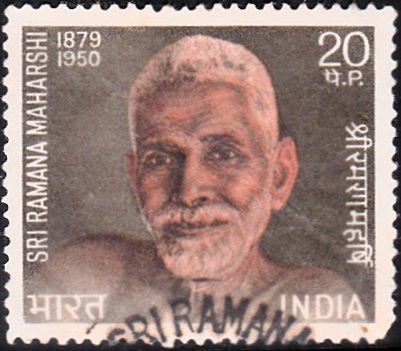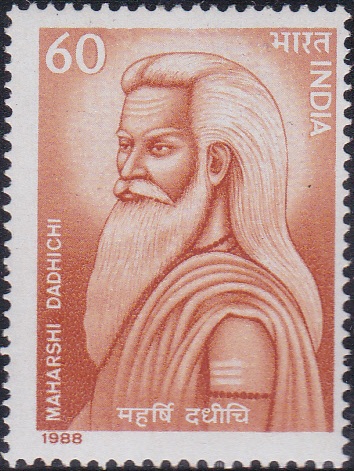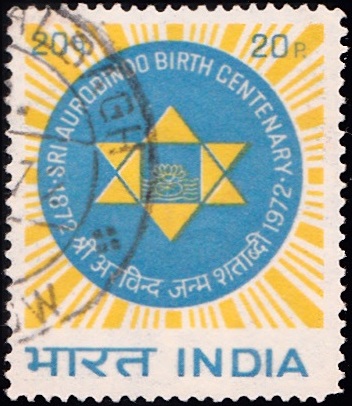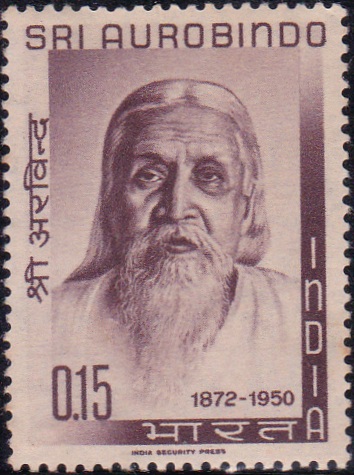
Sri Ramana Maharshi 1971
A commemorative postage stamp on the Death Anniversary of Bhagavan Sri Ramana Maharshi, an Indian sage, philosopher and jivanmukta :
Issued on Apr 14, 1971
Issued for : This holy land of India has given birth to several sages and saints belonging to all faiths from times immemorial. The Indian Posts & Telegraphs Department feels privileged to bring out a special commemorative postage stamp for Sri Ramana Maharshi as he is known to all his devotees.
Description of Design : The design of the Stamp is horizontal and depicts a portrait of Sri Ramana Maharshi.
Type : Stamp, Postal Used
Colour : Brilliant Orange and Raw Sienna
Denomination : 20 Paise
Overall Size : 3.34 X 2.88 cms.
Printing Size : 2.987 X 2.524 cms.
Perforation : 14 x 13½
Watermark : Printed on unwatermarked Adhesive stamp paper
Number Printed : 30,00,000
Number per issue Sheet : 42
Printing Process : Photogravure
Designed and Printed at : India Security Press
Name : Venkataraman Iyer
Born on Dec 30, 1879 at Tiruchuzhi, Madras Presidency, British India
Died on Apr 14, 1950 at Sri Ramana Ashram, Tiruvannamalai, Tamil Nadu, India
About :
- Sri Ramana Maharshi was born on the 30th December, 1879 at Tiruchuzhi near Madurai in Tamil Nadu. He was the second son of Sundaram (meaning beautiful in Sanskrit) lyer and Alagu (meaning beautiful in Tamil) Ammal and was named Venkataraman. When he was seventeen years old, and was studying in High School, he had an extraordinary experience. One day, for no apparent reason, when in perfect health, he felt the hand of death on him. His limbs stretched out, stiff as though rigor mortis had set in. And yet he felt a strong surge of life current as ‘I‘ or Self. From then onwards, he was in the state of SAHAJA (natural) Samadhi in continuous abidance in the Self. The awakening came in June, 1896 and two months thereafter, he left home for Arunachala (Tiruvannamalai). The parting letter ran thus: “I have, in search of my Father, and in obedience to his command, started from here. THIS is only embarking on a virtuous enterprise. Therefore, none need grieve over THIS affair.“ The letter was unsigned with only a few dashes (……) because he had no sense of individual ego. He reached Tiruvannamalai on the 1st of September, 1896 and remained there till he left his mortal coils on the 14th April, 1950, making place considered sacred even more sacred by his living presence.
- It is said that even if one were thousand-tongued, one cannot adequately describe the grace and power which flowed from him. A great sage, Kavyakanta Ganapathi Muni, called him Bhagavan or God for he regarded him as the incarnation of Skanda or Subramania, and named him Ramana, the sweet one, and Maharshi, the great sage. The Maharshi focuses attention on the Quest of the real Self, for which purpose all energies are concentrated in a resolve to find the answer to the question ‘Who am I?’. The question may also take the form of ‘Whence am I?’. ‘Who am I?’ means ‘What is the Truth of me?’. ‘Whence am I?’ means ‘What is the source from which the sense of Self or ‘I’ness emanates’. No answer is to be attempted but the Quest itself enables the seeker to dive into his Heart. The sage assures that this would automatically take the seeker’s mind and merge it in the Heart, the source of Consciousness. This teaching has been described as the Great Yoga or the Maha Yoga because the method suggested is a direct one and does not require any particular belief and can, therefore, be practised by votaries of all religions.
- All creation was the same in the Maharshi‘s eyes. Two incidents in his life would illustrate this. In May, 1922, when his mother was on her death-bed, he sat beside her, his right hand on her heart and his left hand on her head, quietening the mind so that death could be ‘Mahasamadhi‘, absorption in the Self. In the other incident in 1948 he performed the same office for the Ashram cow, Lakshmi.
- From 1896 to 1950, for a span of over 50 years, the Maharshi has been spreading his message for inward peace and realization. The only other parallel to this is Gautama Buddha who lived for about 50 years after Realization. The uniqueness of the Maharshi was also that he was accessible to all at all times and all who turned to him considered themselves blessed.
- The famous French photographer Monsieur Cartier–Brisson related his experience of what happened on the night of the 14th April, 1950 when the Maharshi left his earthly body as follows: “I was in the open space in front of my house, when my friends drew my attention to the sky, where I saw a vividly luminous shooting-star with a luminous tail, unlike any shooting-star I had before seen, coming from the South, and moving slowly across the sky, it reached the top of Arunachala and disappeared behind it.“ This was witnessed by several thousands for hundreds of miles around Tiruvannamalai at the time of the Mahanirvana.
- His message is set out tersely, in the Tamil poems ‘Upadesa Saram‘ and ‘Ulladu Narpadu‘ and in the works of the saint poet Muruganar.
- The Shrine of Grace of Sri Maharshi is situated in Sri Ramanasramam. Again and again, he impressed on all that real Maharshi was not the body which people saw but the inner being, the real Self and that his presence and grace can be felt by all who turn to him in an earnest search for Truth.







